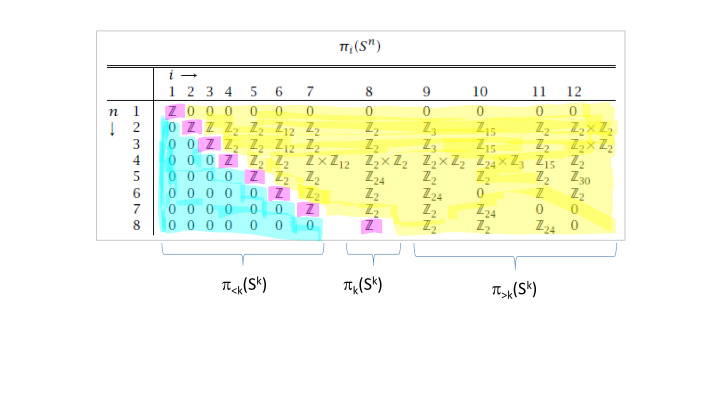



<k (S k ) k (S k ) >k (S k )
Infinite subgroups completely understood
Values stabilize along diagonals: n+k (S k ) = n+k+1 (S k+1 ) for k >> 0
Stable homotopy groups: s := lim n+k (S k ) k n Primary decomposition: s = n ( n 3 s ) (p) s = Z 24 = z 8 + Z 3 e.g.: p prime
Computation: Mahowald-Tangora-Kochman Picture: A. Hatcher • Each dot represents a factor of 2, vertical lines indicate additive extensions 𝑡 ) (2) = ℤ 8 , 𝑡 ) (2) = ℤ 2 ⨁ℤ 2 (𝜌 3 (𝜌 8 e.g.: • Vertical arrangement of dots is arbitrary, but meant to suggest patterns 5
Computation: Nakamura -Tangora Picture: A. Hatcher 6
( n Computation: D. Ravenel s ) (5) Picture: A. Hatcher n • Each dot represents a factor of p ( 39 s ) (5) = Z 25 e.g.: • Vertical arrangement of dots is arbitrary, but meant to suggest patterns
• Each dot represents a factor of 2, vertical lines indicate additive extensions 𝑡 ) (2) = ℤ 8 , 𝑡 ) (2) = ℤ 2 ⨁ℤ 2 (𝜌 3 (𝜌 8 e.g.: • Vertical arrangement of dots is arbitrary, but meant to suggest patterns 8
Computation: Nakamura -Tangora Picture: A. Hatcher 9
( n Computation: D. Ravenel s ) (5) Picture: A. Hatcher n 10
( n s ) (5) v 1 - periodic layer period = 2(p-1) = 8 11
( n s ) (5) v 2 - periodic layer period = 2(p 2 - 1) = 48 12
( n s ) (5) v 3 - periodic layer period = 2(p 3 - 1) = 248 13
14
15 Example: KO (real K-theory)
16
Hurewicz image of TMF (p = 2) 17
Recommend
More recommend